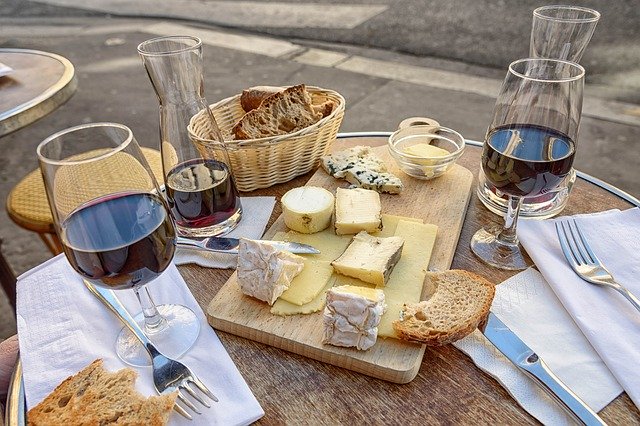A
A
A
Like a burger and fries, wine and cheese are a match made in foodie heaven. But why do these two fit together so well?
Wines and cheeses pair so nicely because they are a delectable combination of an astringent drink and a fatty food. Astringent drinks make the mouth pucker up and fatty foods make the mouth feel slippery. On their own, we do not particularly like these feelings. Fatty foods lubricate the mouth, making it feel slick or even slimy. Astringent foods make the mouth feel rough and dry. By enjoying the two together, a wonderful balance can be struck. Your mouth will not end up too slippery or too dry. The astringent power o the drink cuts through the cheese’s fatty consistency, restoring balance to the mouth.
Pairing Wines and Cheeses
There are a few rules to follow to make your pairing experience as satisfying as possible. To begin with, most cheeseboards will have a spread consisting of goat cheeses, cheddar cheeses, and blue cheeses.
Read More »
Goat Cheeses and Sauvignon Blanc
Chèvre is one of the most popular of the cheeses made from goats milk. This (and other goat cheeses) pair well with Sauvignon Blanc. The acidity of the drink cuts through the fattiness of these cheeses. This pairing has grown to be beloved as a true classic; Sauvignon Blanc has almost a grassy taste to it, which is complimentary to creaminess of Chèvre varieties.
Vermont Cheddar and Sparkling Wine:
Vermont Cheddar is one of the most popular, but most cheddars pair nicely with champagne, sparkling wines, or even cider. The bubbles of sparkling wines pair nicely with the subtle sharpness of cheddar. Many people also enjoy cheddar with a strong ale beer. For easier pairing, a block cheddar between mild and medium sharpness works better. Opt for a cheddar that has reached maturity, with just enough bite and not too much sharpness.
Firm Cheeses and White Wines
Among the firm cheeses are well-known classics like Cheddar, Gouda, Comté, Parmesan, and Grana-Padano. Generally they do not have a rind, and their texture is supple and somewhat elastic. Comté, for example, is one of the most highly produced cheeses in France. There are several oxidized white wines that provide a nice mix with Comté, seamlessly complimenting its nutty flavor profile. White wines from Italy are also wonderful to pair with firm cheeses. White wines can have a dryness which suits most firm varieties. Skin fermented wines are also great; they have consistency similar to many of the red wines.
Port Wines and Bleu Cheeses
Port wines are red and rich; full-bodied, with a touch of sweetness. Bleu Cheeses have a subtle saltiness that pairs well with Port. Pair a slightly chilled glass of fruity Port with one of the funky blue cheeses to experience the perfect balance for your taste buds; hints of both savory and sweet will appease the palette.
Brie and Chardonnay
Brie is of the soft variety of cheeses. It can pair quite wonderfully with the right light red, but fairs best with white wines. The mildly tart taste of Brie is coupled with its creamy smooth texture. It tends to work particularly well with white wines that add acidity without taking away flavor. Traditionally, the best pairing for a Brie cheese is a Chardonnay — ideally, one from a region of Italy. However, any of the light white wines will do well with Brie.
Soft Cheeses and Pinot Noir
Soft, washed-rind cheeses such as Époisses are a perfect match for fuller bodied white wines or lighter bodied red wines like Pinot Noir. Grown in the Burgundy region of France, this is a classic example of pairing two items from the same region.
Cheeselovers and sommeliers worldwide agree that these classic pairings can be delightful for your next event or gathering, or even as a savory at-home treat.






